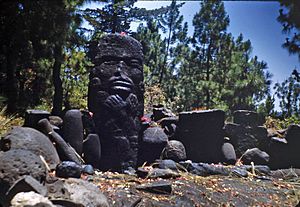Pascual Abaj facts for kids
Quick facts for kids Pascual Abaj |
|
|---|---|
|
Turcaj / Turk'aj / Turuk'aj / Turukaj
|
|

The statue in 1948, before it was defaced
|
|
| Religion | |
| Affiliation | Maya religion |
| District | Quiché Department |
| Region | Guatemalan Highlands |
| Deity | Rey Pascual |
| Location | |
| Municipality | Chichicastenango |
| Country | Guatemala |
Pascual Abaj, also known as Turcaj, is a special stone figure from the ancient Maya civilization. It is called an "idol" and was made long before Christopher Columbus came to America. This ancient statue is located in a town called Chichicastenango in Guatemala.
What makes Pascual Abaj so unique is that it survived the Spanish conquest of Guatemala. Many Maya artifacts were destroyed during that time. Even today, local people still honor and pray to this statue. It is one of the most famous examples of such an ancient Maya figure. Sadly, the statue was damaged in the 1950s by some people from a group called Catholic Action.
Contents
The Story of Pascual Abaj
After the Spanish took control of Guatemala, they wanted people to stop practicing their traditional Maya beliefs. They wanted everyone to become Catholic. Because of this, the stone figure of Pascual Abaj was moved.
It was carried from its original spot in the village of Chichicastenango. People moved it to a nearby hill. This way, they could continue to make offerings and perform ceremonies away from the watchful eyes of the Catholic Church and the Spanish rulers.
What Did Pascual Abaj Look Like?
Before it was damaged, the statue was described as a very unique human-like figure. It had a large head and a forehead that was high and pointed. The statue also had two round earspools, which are like large earrings, placed near its mouth.
Its arms were crossed over its chest, and its fingers were spread out. A rope-like design was carved around its waist. The statue stood about 1 meter (3.3 feet) tall. Someone who saw it in the 1950s thought it looked like it had been buried underground at some point in the past.
Honoring the Ancient Ways
Today, traditional Maya shamans (spiritual leaders) still hold ceremonies at the shrine. They perform these rituals both during the day and at night. The statue sits on a small altar, which is like a special table for offerings.
Many different items are placed around the statue as offerings. These include pine branches, crosses, and fresh flowers. People also offer copal resin, which is a special tree sap used as incense. You can also see items made from stone. This shrine has become a popular place for tourists to visit. They come to see and learn about these ancient Maya ceremonies.
Where to Find Pascual Abaj
The shrine is located on a wooded ridge, which is like a small hill covered in trees. It overlooks the beautiful Chichicastenango valley. The site is about 3 kilometers (1.9 miles) south of the main town. The statue itself is set on a small flat area within a pine forest.
Understanding the Name
The name "Pascual Abaj" has meaning from two different languages. The word Abaj means "stone" in several Maya languages spoken in the highlands, like K'iche' and Kaqchikel.
Pascual means "Easter" in Spanish. So, the name can be thought of as "Easter Stone." People have been calling the figure "King Pascual" and honoring it since at least the 1800s. The K'iche' name for the hill where the shrine is located is Turcaj (or Turk'aj in modern Maya spelling).
See also
 In Spanish: Pascual Abaj para niños
In Spanish: Pascual Abaj para niños



